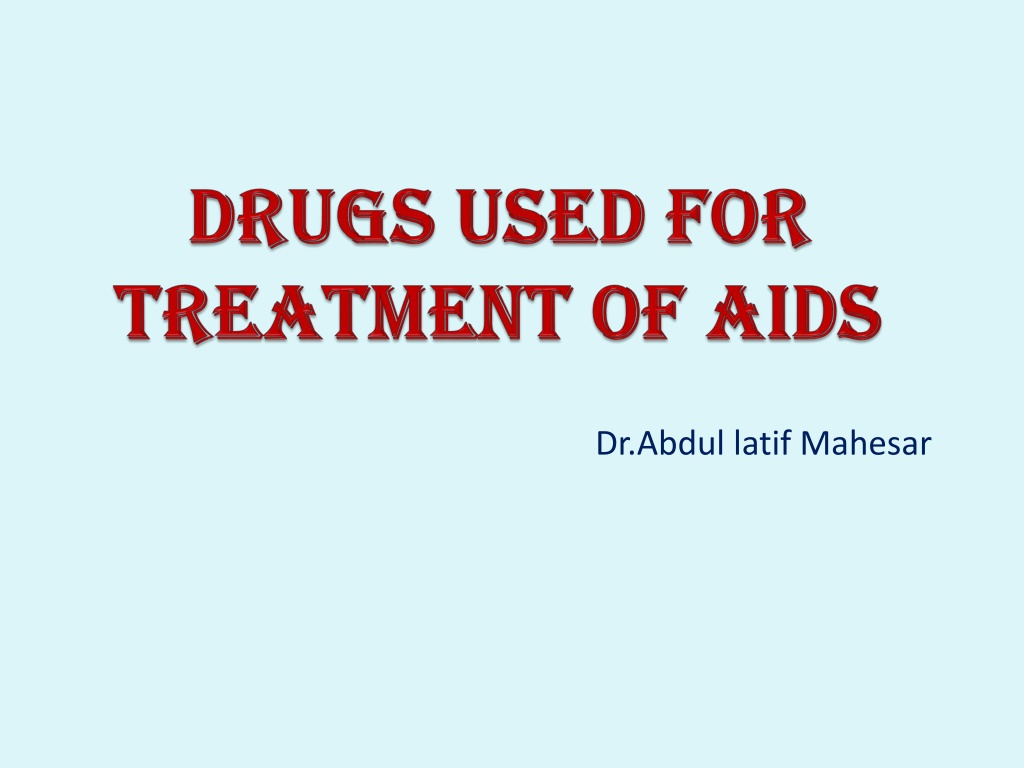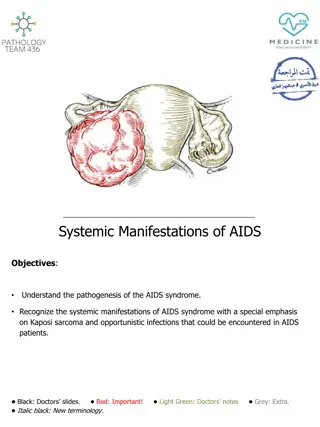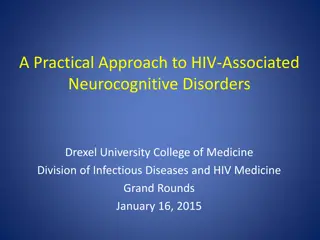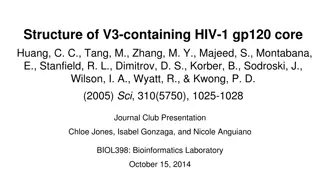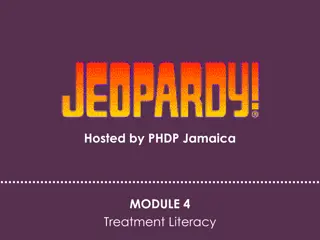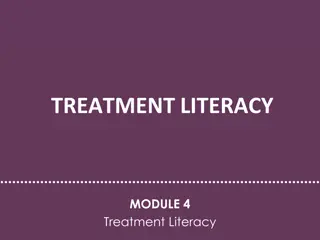Understanding HIV and AIDS: Treatment and Progression
HIV leads to AIDS, a progressive immune system failure allowing life-threatening infections. Effective drugs can extend life by maintaining the immune system and preventing opportunistic infections. Various types of anti-retroviral drugs target different viral components to reduce viral load and maintain the body's defenses. The development of combination therapy, such as HAART, has significantly improved outcomes for HIV patients by reducing rates of AIDS, death, and hospitalization.
Download Presentation

Please find below an Image/Link to download the presentation.
The content on the website is provided AS IS for your information and personal use only. It may not be sold, licensed, or shared on other websites without obtaining consent from the author. Download presentation by click this link. If you encounter any issues during the download, it is possible that the publisher has removed the file from their server.
E N D
Presentation Transcript
How HIVpositive differs from AIDS Does in every case HIV leads to AIDS ?
HIV causes AIDS: This is a progressive failure of immune system which allows life threatening infections and cancers to thrive. Average life after HIV infection goes 9-11 years But by the development of effective drugs ,person may live normal life by carrying a chronic infection for prolong time.
Drugs act on different viral targets Viral load(quantity) is decreased Immune system is maintained Body is prevented from opportunistic infections
Drugs Entry /fusion inibitors Maraviroc , Enfuvertide Nucleoside reverse transcriptase inhibitors zidovudine ,Didanosine ,Emtricitabine Non nucleoside reverse transcriptase inhibitors Nevirapine ,Etraverine Integrase Inhibitors Raltigraver Protease inhibitors Ritonavir Atazanavir
1steffective therapy for HIV was the nucleoside reverse transcriptase inhibitor zidovudine but this drugs or even in combination of drugs from this group were unable to suppress virus for long periods of time and patient eventually dies Later on the development of other drugs, drug from other antiHIV class were used in combination as protease inhibitors indinavir. Then concept of three drug therapy was quickly adapted in to clinical practice this rapidly showed impressive benefit with 60-80% decline in rates of AIDS, death and hospitalization this is called HAART (highly active antiretroviral therapy).
by this way enhanced potency of the drugs is achieved with lesser chances of toxic effects and Emergence of the resistance by the virus is reduced or delayed when multiple drugs are used
When antiretroviral drugs are used improperly multi drug resistance can become dominant . Now days fixed dose combination, three drug therapy is available in one pill which is to be taken as once daily dosing. Antiretroviral drugs can also be use for prevention transmission of virus from one partner to other and from mother to child.
Nucleoside Reverse Transcriptase Inhibitors Zidovudine Are nucleoside & nucleotide analogue, inhibits the enzyme reverse transcriptase. Hence leading to clinical and immunological improvements .can also be used to prevent viral transmission It slow HIV replication but does not stop entirely. Virus may become resistant over time ,usually used in combination.
CD4 count is increased T cell immunity is restored Weight gain by patients suffering from HIV Safely prolong the life of patients with HIV
Mechanism of action Selective reverse transcriptase inhibitors acts as competitive substrate inhibitors and can also be incorporated in to growing viral DNA chain and cause its termination
Zidovudine Zidovudine Pharmacokinetics Orally effective, well absorbed and distributed to most body fluids. Penetrates CSF eliminated by renal excretion, metabolized by hepatic gluccuronidation
It can safely be used in children in low dose It is also used during pregnancy , labor and during delivery. And then to neonates up to six weeks it reduces the risk of development of AIDS to 8%
Side effects Bone marrow depression (neutropenia) Anemia Hepatotoxity Headache Nausea , anorexia Myopathy , fatigue These are reversible either dose is reduced or drug is withdrawn.
Emtricitabine Emtricitabine It Highly absorbed orally, unaffected by food Serum half life 10 hours ,bioavailability for 24 hrs Oral formulation should not be used in a pregnant AIDs patient because it contains a propylene glycol which is a potentially toxic compound for the fetus. also contraindicated in children and patients with renal and hepatic impairment Most common adverse effects headache GIT disturbance Hyper pigmentation of the palms & soles
Didanosine Didanosine Oral bioavilability is 40 % Oral bioavailability is reduced by food it is given in buffer form to avoid acid destruction of the drug Eliminated by the kidney Causes acute pancreatitis there fore avoided to be co administered with other drugs with potential to cause pancreatitis and person with hypertriglycerdemia Can also cause retinal damage and peripheral neuropathy
Non-Nucleoside Transcriptase Inhibitors Nevirapine ( 1stgenerstion), Etravirine ( 2ndgeneration )
Mechanism of action Nevirapine Bind near the active site of the viral reverse transcriptase to inhibit its activety. Binding site is distinct from the NRTIs ( Act as a non-competitive inhibitors of reverse transcriptase enzyme )
Pharmacokinetics Orally effective long serum half life Metabolized in liver extensively Excretion through kidney Inducer of hepatic cytochrome P450 It is typically used as a component of combination therapy Very effective for prevention of transmission as a single dose at time of labor and followed by oral dose to neonate with in three days
Side Effects Hepatotoxicity Skin reaction up to life threatening as Steven- Johnson Syndrome (with nevirapine) Diarrhea Headache Etraverine is very effective against strains which have developed resistance to 1stgenrations Adverse effects most significant rash
Protease inhibitors Ritonavir, Atazanvir Block the viral protease enzyme necessary to produce mature virions ( prevent polyprotein cleavage, which is necessary for the maturation of viral cells )
Pharmacokinetics Atazanavir oral absorption requires an acid environment Once daily dosing Undergoes biliary elimination Enzyme inhibitors P450
Pharmacokinetics Ritonavir it has high bioavailability when given with food administered in slow dose escalation to limit side effects Should be taken with meals Clearance is mainly via the liver Enzyme inhibitors P450
Side effects for protease inhibitors Increased bleeding in hemophilic patients It causes Hyperglycemia & insulin resistance Changes in body fat distribution trunkal obesity, buffalo hump, gynecomastia
Entery /fusion inhibitors Maraviroc Binds selectively to CCR5 at CD4 Absorption rapid but variable most of the drug is excreted in feces Penetrates csf well It is well tolerated with fewer adverse effects
